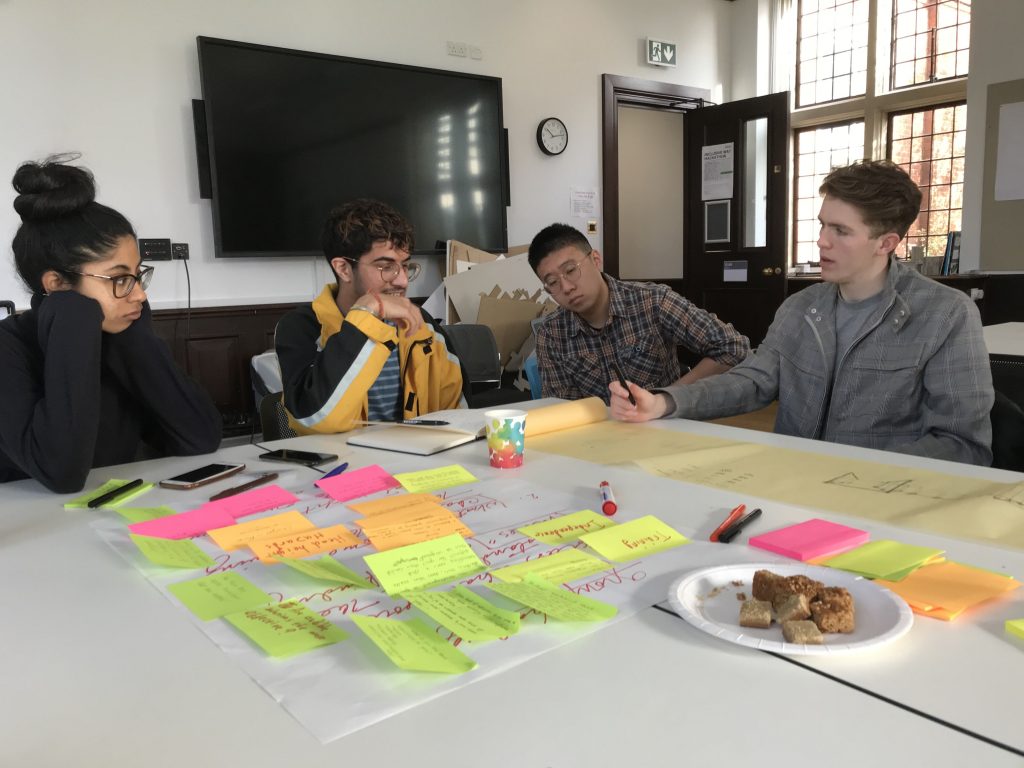Our BdB team are delighted to share our student and staff perspectives on our inspiring February “Inclusive Way” hackathon.
What and when?
A two-day event open to students from all disciplines and years of study to work with people with particular lived experience of disabilities to respond to a wayfinding brief in ways that champion inclusive design solutions. The event was organised for the February “reading week” so that students from different disciplines could work together.
The ‘hackathon’ concept – traditionally utilised within design and computer science disciplines – provides a pedagogical methodology for community/student engagement, teaching and learning around diversity- and inclusion-sensitive design thinking.
Who?
Fifteen students, five design partners, three industry partners and six members of our multidisciplinary BdB partnership teamed up for the “Inclusive Way” hackathon.
- Student participants included undergraduates and postgraduates from Architecture and Construction Management, Information Design, Graphic Communication, Modern Languages, Biomedical Engineering, and Real Estate and Planning.
- They worked with 5 design partners – each living with distinct physical and cognitive impairments. Our design partners included a Reading alumnus and members of the Staff Disability Network.
- Zoe Partington from DisOrdinary Architecture joined us via Skype on Day 1. Wayfinding experts, George Sidaoui and Ellie Baker from Applied Wayfinding, and graphic designer, Rachel Warner from Rachel Warner Design joined the teams on Day 2.
- Our BdB core team members for the day were: Adrian Tagg (Construction Management and Engineering), Carolina Vasilikou (Architecture), Faustina Hwang (Biomedical Engineering), Jeanne-Louise Moys (Typography & Graphic Communication), Richard Nunes (Real Estate and Planning) and Ugo Marsili (Modern Languages).
Where?
The hackathon took place at our beautiful London Road campus (and we were fortunate to have some good weather for most of the outdoor activities). As a point of departure for our hackathon, we treated the university campus and its immediate urban environments as a microcosm of everyday urban experiences. As such, we are reminded that in a context of growing inequality in our societies, the quality of access to services – from parks to shopping and simply getting around – is often lacking despite the regulatory conditions in place for urban design and development. It also should go without saying that “disability” is a socially-constructed term, legally-mandated consideration in placemaking that in itself can throw up barriers by closing down open discussion/debate surrounding the lived experience of disabled “access”.
Why?
We aimed to encourage a cross-disciplinary, open dialogue that would enable participants to build a shared knowledge base about inclusive design and how design can contribute to the lived experiences of people with disabilities.
The hackathon offers a unique pedagogic approach to the complex, multi-faceted problems that are so often under-valued when satisfaction with minimum legal standards leave the quality of life of many users compromised and under-appreciated. The ‘Inclusive Way’ set out to enable a range of literacies – of practical skills in inclusive design, empathy and a co-production of knowledge of diverse experiences of physical and cognitive impairment. It sought to enable a hands-on, solutions-based development model that would echo other successful teaching and learning methods such as problem- and inquiry-based learning approaches.
How?
The first day started with an accessibility treasure hunt to help students look at the campus and its connection to the surrounding public realm and the town centre from an accessibility auditing point of view. We then engaged in group discussions, joined by our design partners and remotely by Zoe Partington (DisOrdinary Architecture) to explore inclusive design principles, practices, opportunities and challenges from different perspectives.
We then introduced a wayfinding brief that asked our multidisciplinary teams to consider how inclusive design can increase the physical, cognitive and cultural accessibility for students, staff and visitors finding their way through specific University outdoor public areas with different physical attributes. Responding to the brief, Hackathon participants worked with design partners to identify a range of user needs and discuss potential wayfinding challenges for people with disabilities or particular needs.
Across the two days, each team was invited to collaboratively identify challenges relative to the needs of their design partners, and to propose solutions. Walk-throughs, models, boards and presentations were produced in the process, and discussed together with input from guest industry professionals and BdB tutors. One highlight was the introduction of “the cube” by Ellie and George from Applied Wayfinding – the cube was designed in collaboration with Avanti Avanti and the Universal Design Foundation as a design tool, to probe the extent to which proposed designs work for a range of user needs and scenarios.
The culmination of the event was the presentations of the design solutions from the two teams, who shared their proposals and prototypes. After the presentations we had a group discussion to share our insights and reflections from the event, and participants also completed an evaluation survey.
So what?
The event highlighted how inclusive design is about supporting independence, social justice and that it’s not about “designing for disabilities” but about designing to support everyone’s needs and lived experiences. As one participant wrote: “Inclusive design is not an add-on [of] inclusivity. It is part of our everyday fabric [and] we should respond to it”.
When asked to rate our event on a scale of 1 to 5, 5 being the most positive experience, all participants replied with 4 or 5 stars. Their comments suggest that they particularly valued:
- Interacting with people with different disabilities and learning from their lived experiences
- Cross-disciplinary collaboration and the opportunity to learn from and share diverse perspectives with peers, professionals and tutors.
Thank you to all participants who made our first hackathon such a success and the University’s Diversity and Inclusion Initiatives Fund for supporting this event. We are already looking forward to planning our next hackathon.





